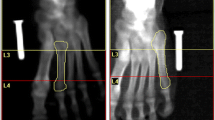Abstract
To estimate subchondral mineralisation patterns which represent the long-term loading history of individual joints, a method has been developed employing computed tomography (CT) which permits repeated examination of living joints. The method was tested on 5 knee, 3 sacroiliac, 3 ankle and 5 shoulder joints and then investigated with X-ray densitometry. A CT absorptiometric presentation and maps of the area distribution of the subchondral bone density areas were derived using an image analyser. Comparison of the results from both X-ray densitometry and CT-absorptiometry revealed almost identical pictures of distribution of the subchondral bone density. The method may be used to examine subchondral mineralisation as a measure of the mechanical adaptability of joints in the living subject.
Similar content being viewed by others
References
Adams J, Chen S, Adams P, Isherwood I (1982) Measurement of trabecular bone mineral by dual energy computed tomography. J Comput Assist Tomogr 6:601
Amtmann E (1971) Mechanical stress, functional adaption and the variation-structure of the femur diaphysis. Ergebn. Anat. Entw.-gesch. Bd. 44, Heft 3, Springer, Berlin Heidelberg New York
Genant HK, Boyd D (1977) Quantitative bone mineral analysis using dual energy computed tomography. Invest Radiol 12:545
Kalender WA, Perman WH, Vetter JR, Klotz E (1986) Evaluation of a prototype dual-energy computed tomographic apparatus. I. Phantom studies. Med Phys 13:334
Knief J-J (1967) Materialverteilung und Beanspruchungsverteilung im coxalen Femurende — Densitometrische und spannungsoptische Untersuchungen. Z Anat EntwGesch 126:81
Konermann H (1971) Quantitative Bestimmung der Materialverteilung nach Röntgenbildern des Knochens mit einer neuen photographischen Methode. Z Anat EntwGesch 134:13
Kouris K, Spyrou NM, Jackson DF (1982) Imaging with ionizing radiations, 1st edn. Surrey University Press, Glasgow London
Kummer B (1968) Die Beanspruchung des menschlichen Hüftgelenks. I. Allgemeine Problematik. Z Anat Entw-Gesch 127:277
Kummer B (1972) Biomechanics of bone: Mechanical properties, functional structure, functional adaptation. In: Fung YC, Perrone N, Anliker M (eds) Biomechanics: Its foundations and objectives. Prentice Hall, Englewood Cliffs, p 237
Maquet P, Van de Berg A, Simonet J (1975) Femoro-tibial weight-bearing areas. J Bone Joint Surg [Am] 57:766
Meema HE, Harris CK, Porett RE (1964) A method for determination of bone-salt content of cortical bone. Radiology 82:986
Möllers N, Lehmann K, Koebke J (1986) Die Verteilung des subchondralen Knochenmaterials an der distalen Gelenkfläche des Radius. Anat Anz 161:151
Molzberger H (1973) Die Beanspruchung des menschlichen Hüftgelenks. IV. Analyse der funktionellen Struktur der Tangentialfaserschicht des Hüftpfannenknorpels. Z Anat EntwGesch 139:283
Murphy SB, Walker PS, Schiller AL (1984) Adaptive changes in the femur after implantation of an Austin Moore prothesis. J Bone Joint Surg [Am] 66:437
Noble J, Alexander K (1985) Studies of tibial subchondral bone density and its significance. J Bone Joint Surg [Am] 67:295
Odgaard A, Pedersen CM, Bentzen SM, Jorgensen, Hvid I (1988) Density changes at the proximal tibia after medial meniscectomy. 6th Meeting of the European Society of Biomechanics, Bristol
Pauwels F (1980) Biomechanics of the locomotor apparatus. Springer, Berlin
Rao GU, Yaghmai I, Wist AO, Arora G (1987) Systematic errors in bone-mineral measurements by quantitative computed tomography. Med Phys 14:62
Schlegel W, Deutsches Krebsforschungszentrum Heidelberg (Personal communication)
Schleicher A, Tillmann B, Zilles K (1980) Quantiative analysis of x-ray images with a television image analyser. Microscopia Acta 83:189
Steiger P, Rüegsegger P, Felder M (1985) Three-dimensional evaluation of bone changes in joints of patients who have rheumatoid arthritis. J Comput Assist Tomogr 9:622
Author information
Authors and Affiliations
Rights and permissions
About this article
Cite this article
Müller-Gerbl, M., Putz, R., Hodapp, N. et al. Computed tomography-osteoabsorptiometry for assessing the density distribution of subchondral bone as a measure of long-term mechanical adaptation in individual joints. Skeletal Radiol 18, 507–512 (1989). https://doi.org/10.1007/BF00351749
Issue Date:
DOI: https://doi.org/10.1007/BF00351749




